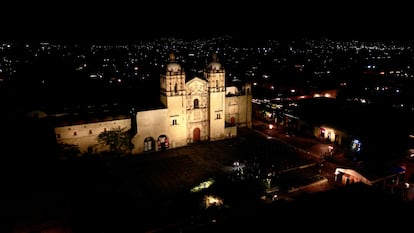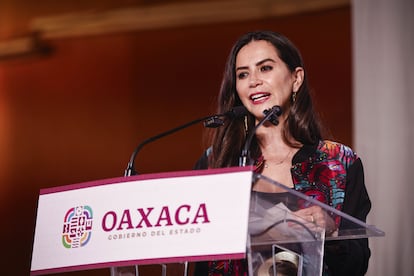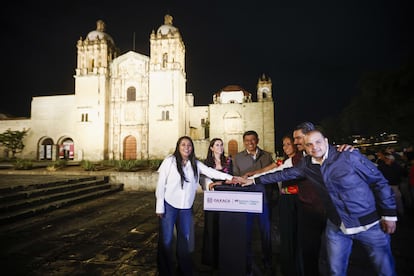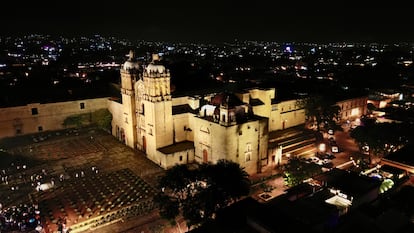Oaxaca continues to illuminate its heritage with cutting-edge technology


Oaxaca has been and continues to be one of the strongest and most decisive bastions for understanding Mexico's importance in the world. Thanks to its resilience and historical, social, and cultural complexity, this state—the tenth most populous in the country—has been able to fully integrate and express the passage of time, a fact visible in the depth of its traditions, the consistency of its cuisine, and especially its astonishing architecture.
One of the clearest examples is the Temple of Santo Domingo de Guzmán, a building that has stood for centuries since 1575 in the heart of Oaxaca de Juárez, transcending its function as a religious center and a source of historical pride belonging to the New Spain Baroque period of Latin America. It's no coincidence that this church, which is also a vital part of the identity and public life of the Oaxacans, as well as a meeting point and a major attraction for visitors who year after year marvel at its majesty and beauty, is also part of the historic center of Oaxaca, which was designated a World Heritage Site by UNESCO in 1987.
Thanks to the combined will of local governments and the energy company Iberdrola México, through the México Brilla program, the new lighting of the Santo Domingo de Guzmán Temple was turned on on June 30, giving continuity to the project presented in 2023 , which includes the efficient lighting of a dozen historical buildings in the entity, where technological avant-garde, energy efficiency, art and the preservation of historical heritage are integrated.
Raymundo Chagoya Villanueva, mayor of Oaxaca, said during the lighting ceremony that this initiative paves the way for a more sustainable future for the state, one that is visible to the world. “I really like the name Oaxaca Brilla because, without a doubt, our state is shining brighter and brighter. It's an initiative that is part of a national effort to artistically illuminate the main historic buildings of our capital city. In 2024, Iberdrola México illuminated the Metropolitan Cathedral of Oaxaca, and today it's the turn of the Temple of Santo Domingo de Guzmán. This year, the Temple of San Matías Jalatlaco and the Basilica of Our Lady of Solitude, patron saint of the capital city, will also be added.”

For her part, Katya Somohano, CEO of Iberdrola México, expressed that illuminating the Santo Domingo de Guzmán Temple not only beautifies one of Oaxaca's most representative icons, but also reflects the company's commitment to the environment, turning the city into a model of sustainability.
“Iberdrola México sees Oaxaca as a place of invaluable wealth, not only because of its rich cultural heritage, but also because it was here that we began our presence in the country with renewable energy. We have three wind farms in the La Ventosa and Juchitán regions [...]. And that's what it's all about: wholeheartedly expressing our gratitude to the people of Oaxaca who have opened their homes to Iberdrola México,” emphasized the head of the energy company in Mexico.

In addition to the collaborative efforts, specialized knowledge, and sustainable approach of private enterprise, state and local governments, as well as public conservation, preservation, and promotion bodies, the lighting of the iconic Santo Domingo Temple once again benefited from the expertise of the Varona company—which has illuminated historical wonders of the world—thus ensuring sustainable, ecological, and efficient macro-lighting, but above all, naturally beautiful.
“What we sought was for the temple to shine on its own, not to try to create effects with the lighting, dramatic or artistic lighting that would take center stage. The temple is the important thing, what must be contemplated without distortion. That's why we shied away from color, dramatic effects, making it seem as if the light is coming from the temple instead of being placed in different places within it [...]. The most efficient lighting fixtures on the market were used. The fixtures are very efficient, and then we chose optics that project all the light toward the temple, without losing any of it into the atmosphere,” explained Roberto Lurueña, director of Varona, the company responsible for lighting the ten buildings included in the México Brilla program.

In the second half of the year, both the Basilica of the Virgin of Solitude and the Temple of San Matías Jalatlaco will be illuminated, while in the following three years, work is planned on the temples of San Felipe Neri, the Precious Blood of Christ, the Society of Jesus, and San Agustín, as well as the Macedonio Alcalá Theater and the Government Palace of Oaxaca.
EL PAÍS




%3Aformat(jpg)%3Aquality(99)%3Awatermark(f.elconfidencial.com%2Ffile%2Fbae%2Feea%2Ffde%2Fbaeeeafde1b3229287b0c008f7602058.png%2C0%2C275%2C1)%2Ff.elconfidencial.com%2Foriginal%2Faaa%2F43f%2Fc04%2Faaa43fc04c58b7039fe502f7b2a09e5a.jpg&w=1280&q=100)
%3Aformat(jpg)%3Aquality(99)%3Awatermark(f.elconfidencial.com%2Ffile%2Fbae%2Feea%2Ffde%2Fbaeeeafde1b3229287b0c008f7602058.png%2C0%2C275%2C1)%2Ff.elconfidencial.com%2Foriginal%2F19d%2F3b9%2Fb11%2F19d3b9b11ce3f21f297aebaaf0ad7ac2.jpg&w=1280&q=100)